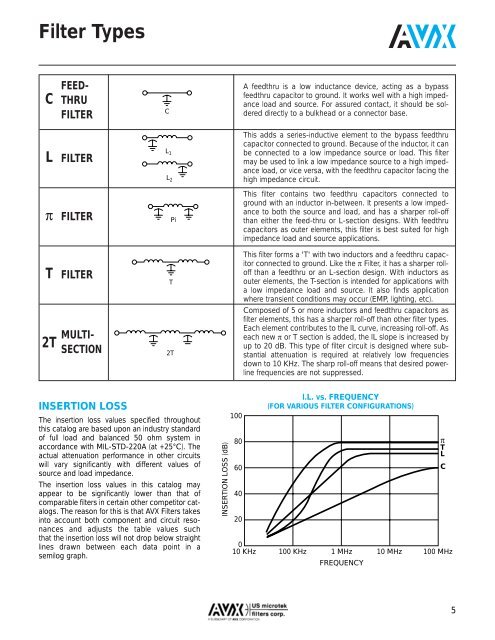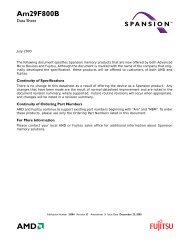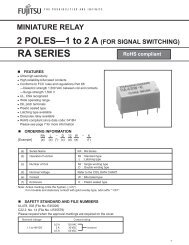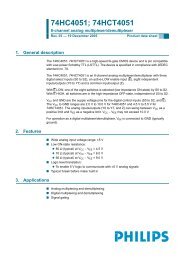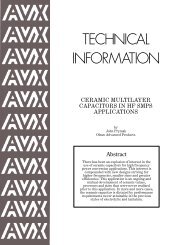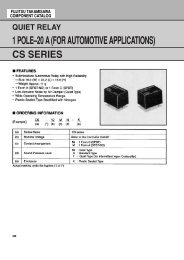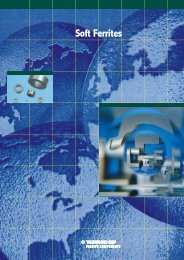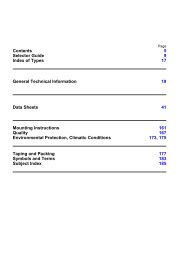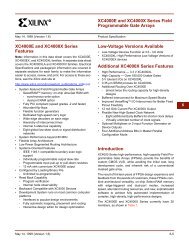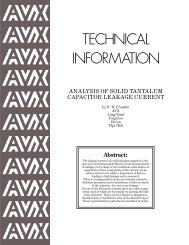AVX US Microtek EMI Filters Catalog - RYSTON Electronics sro
AVX US Microtek EMI Filters Catalog - RYSTON Electronics sro
AVX US Microtek EMI Filters Catalog - RYSTON Electronics sro
You also want an ePaper? Increase the reach of your titles
YUMPU automatically turns print PDFs into web optimized ePapers that Google loves.
Filter Types<br />
FEED-<br />
C THRU<br />
FILTER<br />
L FILTER<br />
C<br />
L 1<br />
A feedthru is a low inductance device, acting as a bypass<br />
feedthru capacitor to ground. It works well with a high impedance<br />
load and source. For assured contact, it should be soldered<br />
directly to a bulkhead or a connector base.<br />
This adds a series-inductive element to the bypass feedthru<br />
capacitor connected to ground. Because of the inductor, it can<br />
be connected to a low impedance source or load. This filter<br />
may be used to link a low impedance source to a high impedance<br />
load, or vice versa, with the feedthru capacitor facing the<br />
high impedance circuit.<br />
π FILTER<br />
T FILTER<br />
MULTI-<br />
2T SECTION<br />
L 2<br />
Pi<br />
T<br />
2T<br />
This filter contains two feedthru capacitors connected to<br />
ground with an inductor in-between. It presents a low impedance<br />
to both the source and load, and has a sharper roll-off<br />
than either the feed-thru or L-section designs. With feedthru<br />
capacitors as outer elements, this filter is best suited for high<br />
impedance load and source applications.<br />
This filter forms a 'T' with two inductors and a feedthru capacitor<br />
connected to ground. Like the π Filter, it has a sharper rolloff<br />
than a feedthru or an L-section design. With inductors as<br />
outer elements, the T-section is intended for applications with<br />
a low impedance load and source. It also finds application<br />
where transient conditions may occur (EMP, lighting, etc).<br />
Composed of 5 or more inductors and feedthru capacitors as<br />
filter elements, this has a sharper roll-off than other filter types.<br />
Each element contributes to the IL curve, increasing roll-off. As<br />
each new π or T section is added, the IL slope is increased by<br />
up to 20 dB. This type of filter circuit is designed where substantial<br />
attenuation is required at relatively low frequencies<br />
down to 10 KHz. The sharp roll-off means that desired powerline<br />
frequencies are not suppressed.<br />
INSERTION LOSS<br />
The insertion loss values specified throughout<br />
this catalog are based upon an industry standard<br />
of full load and balanced 50 ohm system in<br />
accordance with MIL-STD-220A (at +25°C). The<br />
actual attenuation performance in other circuits<br />
will vary significantly with different values of<br />
source and load impedance.<br />
The insertion loss values in this catalog may<br />
appear to be significantly lower than that of<br />
comparable filters in certain other competitor catalogs.<br />
The reason for this is that <strong>AVX</strong> <strong>Filters</strong> takes<br />
into account both component and circuit resonances<br />
and adjusts the table values such<br />
that the insertion loss will not drop below straight<br />
lines drawn between each data point in a<br />
semilog graph.<br />
INSERTION LOSS (dB)<br />
100<br />
80<br />
60<br />
40<br />
20<br />
I.L. vs. FREQUENCY<br />
(FOR VARIO<strong>US</strong> FILTER CONFIGURATIONS)<br />
0<br />
10 KHz 100 KHz 1 MHz<br />
FREQUENCY<br />
π<br />
T<br />
L<br />
C<br />
10 MHz 100 MHz<br />
5


